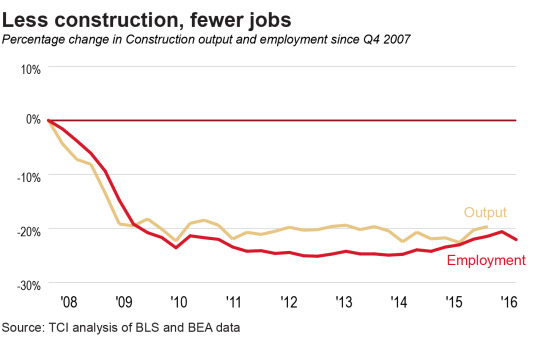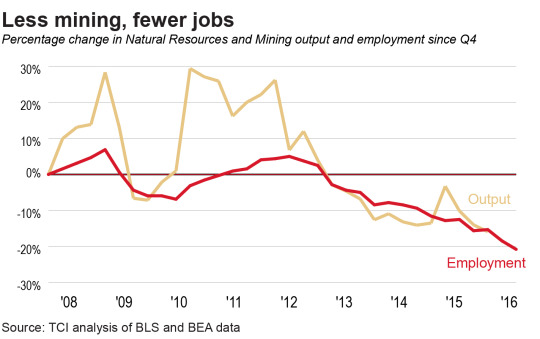May 13, 2016
More Manufacturing, But Fewer Jobs
In our recent report, Patchwork Recovery, we explained that there have been strong employment gains in service-providing industries like education and health services but almost no growth in goods-producing industries like manufacturing and mining.
Within that split, something else caught our attention: In most goods-producing industries output runs on the same trend line as jobs – less output, fewer jobs. But manufacturing output is actually up at the same time that employment is down – way down. This paradox is one of the many trends driving the state’s uneven job growth and has implications for the future of Virginia’s economy.
Let’s look at some numbers.
Virginia’s economy continues to gain steam after the long slog of the last recession and the federal government budget austerity that followed. In the first three months of 2016, the state added nearly 20,000 jobs after adjusting for seasonal fluctuations, and almost 100,000 jobs over the last year. But roughly 95,000 of the annual job gains were in service-providing sectors like education, health, and business services. Goods-producing employment in sectors like mining, manufacturing, and construction remained close to flat.
Looking over a longer time period, employment in construction, natural resources and mining, and manufacturing is a combined 95,000 jobs below pre-recession levels. That’s an 18 percent drop. Each sector has its own story.
For construction, the trend is clear. The bursting of what might be a once-in-a-lifetime housing bubble caused a sharp decrease in both the total output of all construction products – a measure that includes both the quantity and price of constructed goods such as housing and office buildings – and construction employment.

The story is a little noisier but still clear for Mining and Natural Resources employment. International demand for metallurgical coal increased output and employment between 2007 and 2012, but the subsequent collapse of that demand and the growth of natural gas have caused a significant drop in coal mining activity and employment in Virginia (see: Coal Tax Credits Aren’t Working).

But the story is less clear for manufacturing. Output increased 3 percent between the fourth quarter of 2007 and the third quarter of 2015, yet manufacturing employment decreased by more than 14 percent. Since before the last recession, Virginia has lost more than 40,000 manufacturing jobs but added more than a billion dollars in manufacturing output even after adjusting for inflation.

Manufacturing productivity, roughly the average value of stuff made by each employee, increased as output grew but employment fell.
This could have happened because of technological change or shifting composition of employment within industries. In the first case, factories adopt new technologies, like robotics, to replace people or make each person able to produce more goods. In the second, a high-value, low-labor industry replaces a low-value, high-labor intensive industry. For example, high-end craft breweries and wineries replace textile mills and furniture factories.
There are indications that it’s the second story at work in Virginia. Between 2007 and 2013, food, beverage, and tobacco products manufacturing increased 40 percent while furniture manufacturing decreased 51 percent, textile mills decreased 57 percent, and petroleum and coal manufacturing decreased 65 percent. Simply put, manufacturing is a quickly changing sector in Virginia’s changing economy.
Productivity growth can be a driver of growing compensation and increased living standards. Increased employment can be an important way to make sure the gains of the economy are shared with more workers and families. Virginia’s economy is getting healthier, but it still needs consistent increased employment and increased productivity in a broad range of sectors to make up for missed growth over the last eight years.
Category:
Economic Opportunity
